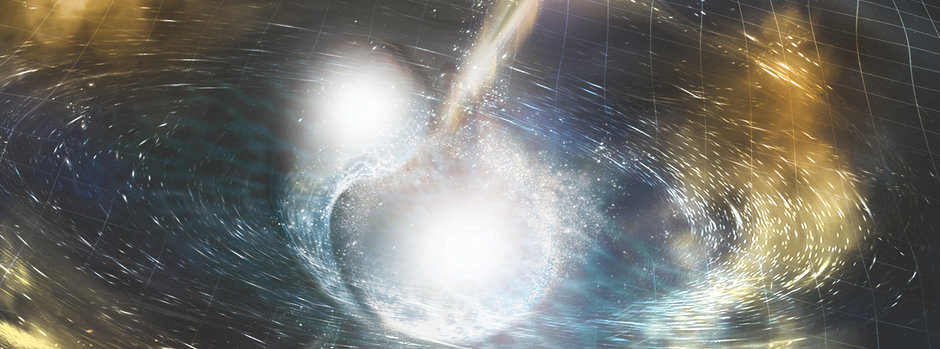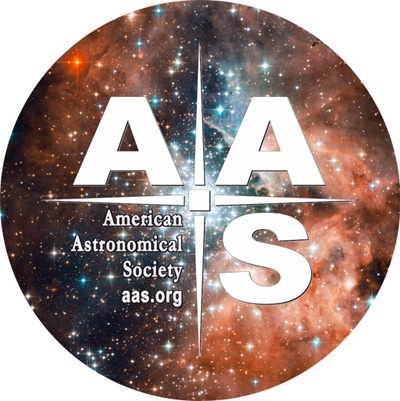11 December 2020
Susanna Kohler

When neutron stars collide, the shell of expanding ejecta can interact with the surrounding interstellar medium, producing long-lived radio flaring. Credit: NASA’s Goddard Space Flight Center/CI Lab.
When a pair of neutron stars collide, they emit a fireworks show. Could some of the low-energy light produced in these mergers be detectable years later? A team of scientists thinks so — and they’re pretty sure they’ve found an example.
A Rainbow of Signals
In addition to gravitational waves, a slew of electromagnetic radiation is produced in the merger of two neutron stars, spanning the spectrum from gamma rays to radio waves.
In 2017, the now-famous neutron star collision GW170817 gave us a first look at this expected emission: it revealed a short gamma-ray burst, infrared and optical light from ejecta in a kilonova, and relatively short-lived X-ray and radio afterglows caused by high-speed outflows.

GW170817
https://www.ligo.org/detections/GW170817.php

Cataclysmic Collision Artist’s illustration of two merging neutron stars. The rippling space-time grid represents gravitational waves that travel out from the collision, while the narrow beams show the bursts of gamma rays that are shot out just seconds after the gravitational waves. Swirling clouds of material ejected from the merging stars are also depicted. The clouds glow with visible and other wavelengths of light.Credit: NSF/LIGO/Sonoma State University/A. Simonnet.
But there’s one expected type of emission that was missing from GW170817, and it’s never before been spotted in any neutron star collision: radio flaring.

https://www.nde-ed.org/EducationResources/HighSchool/Radiography/characterradiation.htm

Illustration of radio emission from a neutron star merger. During the merger, some neutron star matter is flung outward. This ejecta interacts with the interstellar gas, producing a years-long radio flare. [Lee et al. 2020]
Radio Secrets Revealed
Models of neutron star mergers predict that when ejecta are flung out from the stellar collision, they’ll expand into space, eventually running into the surrounding medium of interstellar gas and dust. The subsequent interaction of the ejecta with the interstellar medium should produce radio flaring.
The emission from these radio flares is expected to be quite long-lived — lasting for years or even decades — which means we could hope to find these signals long after the time of the explosion that produced them. But radio flares are also likely to be relatively faint, so we could only expect to spot flares from nearby collisions (within ~650 million light-years). Additionally, only mergers that occur in environments with dense surrounding gas and dust will light up brightly enough for us to spot.
With these constraints, it’s perhaps not surprising that we haven’t found any radio flares marking past mergers yet. But a team of scientists led by Kyung-hwan Lee (University of Florida) recently waded through decades of radio data from the Very Large Array — and in a recent publication, they’re announcing that one transient may be the first identified radio flare from a stellar collision.

A Decades-Old Collision

Observational data for FIRST J1419+3940 and best-fit radio light curves at three different frequencies. The data are better fit by the neutron-star-merger model (solid lines) than the long-gamma-ray-burst model (dashed lines). Credit: Lee et al. 2020.
FIRST J141918.9+394036 is a radio transient located in a dwarf galaxy 280 million light-years away. Lee and collaborators compile survey data on this source spanning 23 years and evaluate possible explanations for the radio emission.
While this source could potentially be explained as a long-gamma-ray-burst afterglow — light from an off-axis jet produced by a collapsing star — the radio data aren’t fit best by this picture. Instead, the authors show via models that this transient’s light curve is best described as the decay of a radio flare, just as predicted from a neutron star merger. This means that FIRST J141918.9+394036 likely marks a decades-old collision of two stars.
Within a few years, further observations of FIRST J141918.9+394036 will allow us to better distinguish between models and confirm its nature. And as we find more signals like this one, we can use these observations to further understand the origin and physics of neutron star mergers — potentially illuminating everything from the formation channel of binaries to the equation of state for neutron stars.
Citation
“FIRST J1419+3940 as the First Observed Radio Flare from a Neutron Star Merger,” K. H. Lee et al 2020 ApJL 902 L23.
https://iopscience.iop.org/article/10.3847/2041-8213/abbb8a
See the full article here .

five-ways-keep-your-child-safe-school-shootings
Please help promote STEM in your local schools.

AAS Mission and Vision Statement
The mission of the American Astronomical Society is to enhance and share humanity’s scientific understanding of the Universe.
The Society, through its publications, disseminates and archives the results of astronomical research. The Society also communicates and explains our understanding of the universe to the public.
The Society facilitates and strengthens the interactions among members through professional meetings and other means. The Society supports member divisions representing specialized research and astronomical interests.
The Society represents the goals of its community of members to the nation and the world. The Society also works with other scientific and educational societies to promote the advancement of science.
The Society, through its members, trains, mentors and supports the next generation of astronomers. The Society supports and promotes increased participation of historically underrepresented groups in astronomy.
The Society assists its members to develop their skills in the fields of education and public outreach at all levels. The Society promotes broad interest in astronomy, which enhances science literacy and leads many to careers in science and engineering.
Adopted June 7, 2009
